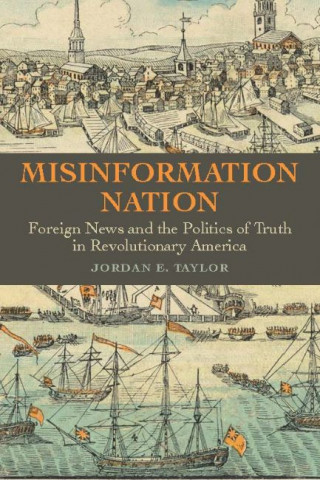The Book
Misinformation Nation: Foreign News and the Politics of Truth in Revolutionary America
The Author(s)
Jordan E. Taylor

Identifying striking similarities with our present politics and media, Jordan Taylor argues that the late eighteenth century “witnessed the birth of not only modern democratic politics but also modern information politics”.[1] The Age of Revolutions both fueled and was fueled by a massive volume of information, a news-hungry public that tended to treat “truth as a commodity,” and “political factions that sustained themselves by molding the truth while accusing their rivals of doing the same” .[2] Why did the American Revolution happen? Through his careful reconstruction of early Americans’ “informational worlds,” Taylor suggests it was in no small part due to misperceptions .[3]
Misinformation Nation traces changes in information networks, mediation, and the politicization of news starting with British imperial conflicts in the late eighteenth century and continuing through the polarized politics of the 1790s in the United States and its neighboring European colonies. Throughout this thought-provoking and engaging book, Taylor examines how people got information, what they did with it, and why the circulation of more information often led to polarized, volatile, and even revolutionary politics. While he suggests that there was no “one decisive American Revolution,” Taylor argues that the several revolutionary changes marking the late eighteenth century amounted to not only a political revolution, but one of information.
The first two chapters cover what Taylor calls a “mediation revolution” (21) over the course of the eighteenth century and the anxieties it produced. Whereas information—foreign news especially—was hard to come by in seventeenth-century America, communication flows increased going into the eighteenth century. The need to sift and distribute news led to more centralized and hierarchical communication processes, with mediators focused on disseminating information rather than discerning truth. The result was “more efficient distribution of news, but not necessarily of truth”.[4] Americans were not unaware of the rash of falsehood and misperception that circulated, especially back and forth across the Atlantic. In the years preceding the outbreak of the Revolution, Taylor traces how colonists became convinced that intermediaries were misrepresenting the situation in the colonies to imperial officials back in London. “American colonists went after the evils of mediation itself,” he writes.[5] Independence took so long to declare because Americans continued to hope that the truth would win out and the British would change course accordingly. Distance becomes a key explanatory factor throughout the book, in a manner similar to Trish Loughran’s The Republic in Print (Columbia University Press, 2007) or Kenneth Bank’s Chasing Empire Across the Sea (McGill-Queen’s University Press, 2003).
From there, Taylor identifies the rise of Patriot newspaper printers as arbiters of truth, proclaiming to help their readers navigate “a sea of contradiction and falsehood”.[6] Colonists began to consider the truth of information to be more salient than its newsworthiness. Yet, because printers lacked reliable methods to distinguish truth from falsehood, they began to make judgments based on the perceived political motives of their sources. Throughout their struggle for independence, Taylor traces how Americans sought out news they wanted to hear from Europe—and once they were independent, how they tried to diversify where they got foreign news in an effort to escape what they viewed as the deceptive and manipulative London press.
The second half of the book looks at what Americans did once they began to believe that information could lead to revolution. He identifies a belief in what he calls an “information script” of revolution, which meant that many became convinced that news of successful revolutions could spark others.[7] Based on this, Taylor shows, both revolutionary activists and state officials hoping to prevent revolutions battled to control information flows and settle the truth of news. In French and British colonies this tension was more clear-cut, but in the young United States, the conflict played out along political lines as nascent parties struggled to control perceptions of the French Revolution. “In North America,” Taylor asserts, “there was no one French Revolution, but many”.[8] In chapter 8, Taylor looks at early American (mis)understandings of the Haitian Revolution and attributes them in no small part to the limitations of the information networks available. “At moments of ferment, white Americans had little knowledge of the intentions of Caribbean revolutionaries, but instead saw only consequences of their actions”.[9]
The book culminates with the Alien and Sedition Acts of 1798, which Taylor suggests represented an effort to reign in the democratization of mediation and its effects. The backlash to these policies solidified what he calls a “permissive news culture” that Americans continue to inhabit. Throughout the book, Taylor draws connections between the past and present when it comes to the challenges of the media landscape—and he suggests some of them are as old as the country itself. “Truth does not simply happen,” he concludes, “it must be nurtured”.[10] The book ends with a call for more uncertainty and verification. While this may seem unlikely, Taylor reminds us that “so did all revolutions until they became inevitable”.[11]
[1] Jordan E. Taylor, Misinformation Nation: Foreign News and the Politics of Truth in Revolutionary America. Baltimore: Johns Hopkins University Press, 2022, 2.
[2] Ibid., 3.
[3] Ibid., 14.
[4] Ibid., 39.
[5] Ibid., 45.
[6] Ibid., 9.
[7] Ibid., 106.
[8] Ibid., 151.
[9] Ibid., 176.
[10] Ibid., 219.
[11] Ibid., 224.
About the Reviewer
Katlyn Marie Carter is an Assistant Professor of History at the University of Notre Dame. She is the author of Democracy in Darkness: Secrecy and Transparency in the Age of Revolutions (Yale University Press, 2023).

0